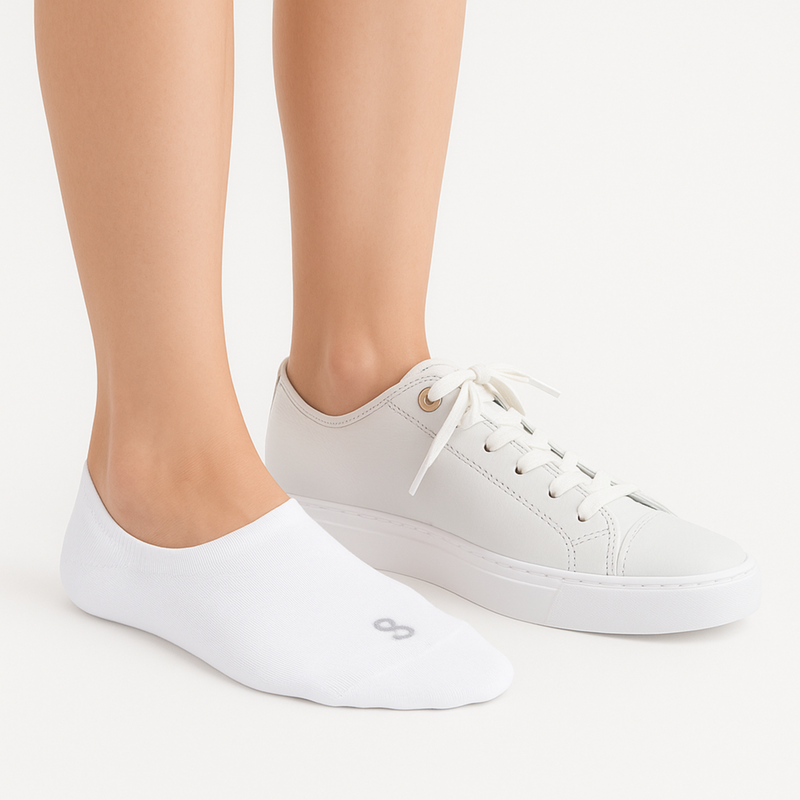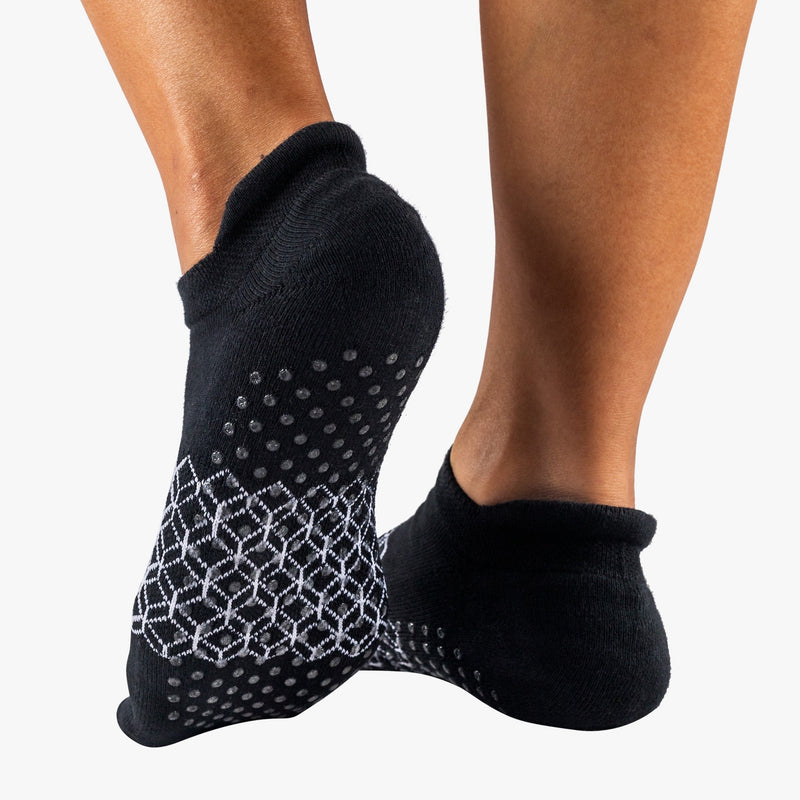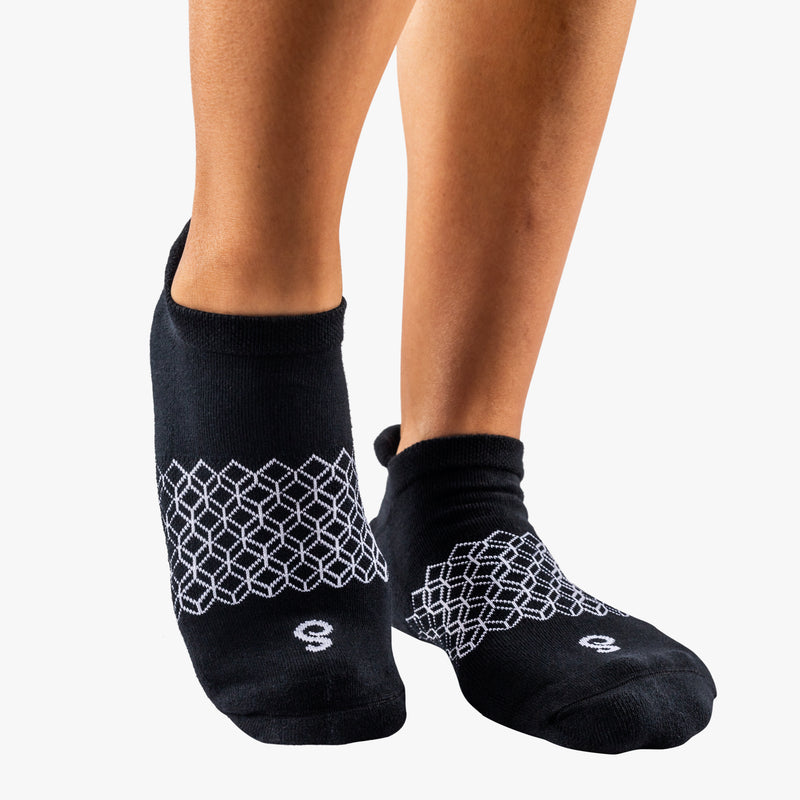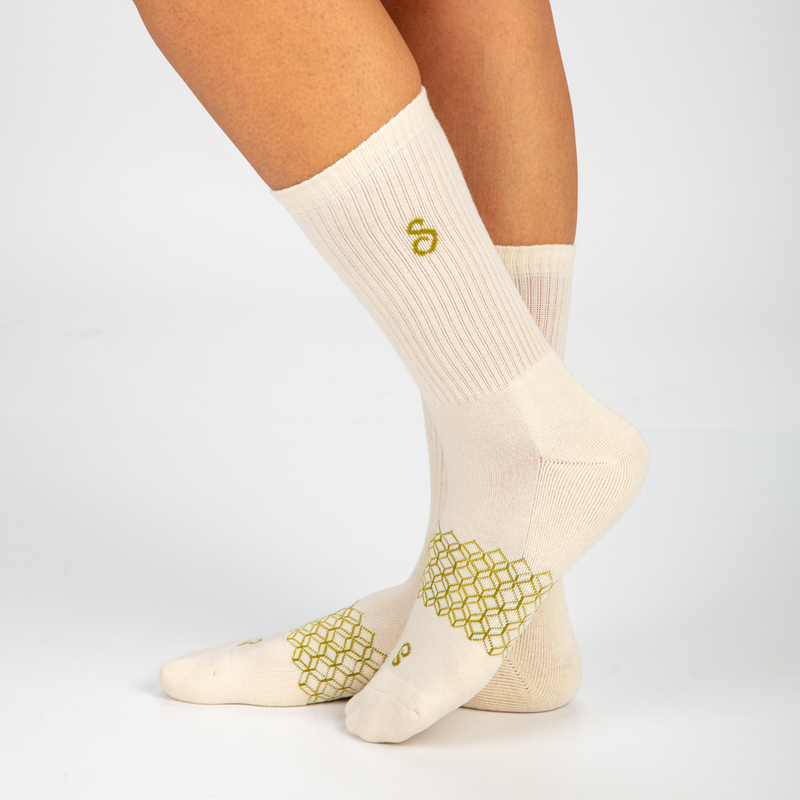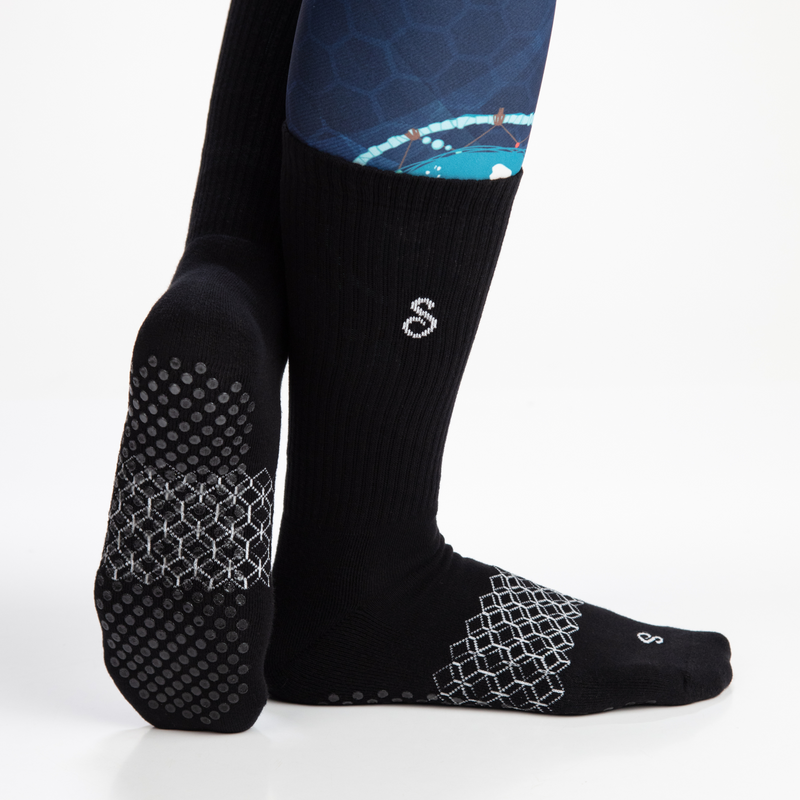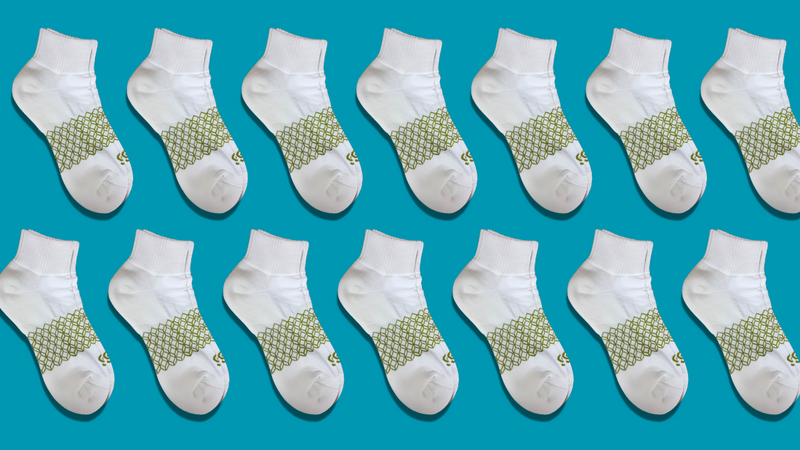
Quarter socks sit between ankle socks and crew socks, extending just above the ankle bone for optimal comfort and style. Their versatile design makes them a practical choice for various activities and footwear options.
Quarter socks offer enhanced ankle protection whilst preventing the friction and blisters commonly associated with lower-cut varieties. The strategic length keeps them visible above most trainers and casual shoes without appearing too sporty or formal.
These socks have gained popularity among athletes and everyday wearers alike, thanks to their ability to stay in place during movement. The balanced cut provides just enough coverage to prevent shoes from rubbing against bare skin whilst maintaining a streamlined appearance.
What Are Quarter Socks?
Quarter socks extend just above the ankle bone, offering a perfect balance between ankle socks and crew socks. These versatile socks provide comfort and protection whilst maintaining a modern, sporty appearance.

Definition
Quarter socks are athletic-style socks that rise approximately 2-3 inches above the ankle bone. They feature a ribbed cuff that keeps the sock securely in place during physical activities.
The design includes extra cushioning around the heel and toe areas to prevent blisters and provide enhanced comfort. Many quarter socks incorporate moisture-wicking materials like cotton blends, polyester, or merino wool.
These socks typically include arch support bands and mesh ventilation panels to improve breathability and maintain foot stability.
Height Comparison With Other Socks
Quarter socks sit higher than no-show and ankle socks but lower than crew and mid-calf varieties. Here's how they measure up:
Sock Heights (From Lowest to Highest):
- No-show socks: Below ankle bone
- Ankle socks: At ankle bone
- Quarter socks: 2-3 inches above ankle
- Crew socks: Mid-calf
- Knee-high socks: Below knee
Quarter socks provide optimal coverage for most athletic trainers and hiking boots. The height prevents chafing from footwear whilst avoiding the bulk of taller sock styles.
Benefits of Quarter Socks
Quarter socks provide essential foot protection, adapt to various activities, and complement modern fashion choices. They strike an ideal balance between full-length socks and no-show options.
Protection and Comfort
Quarter socks deliver targeted cushioning at high-impact areas, including the heel and ball of the foot. The reinforced toe sections prevent friction and reduce the risk of blisters during activities.
The elastic band sits comfortably above the ankle, preventing the sock from sliding down whilst maintaining proper circulation. This placement protects the Achilles tendon from shoe friction.
The breathable materials used in quarter socks help regulate foot temperature and manage moisture effectively. Many designs incorporate mesh panels for enhanced ventilation.
Versatility in Use
Quarter socks excel in both athletic and casual settings. They pair perfectly with trainers, hiking boots, and casual footwear.
Athletes favour quarter socks for running, tennis, squash, and gym workouts due to their stability and moisture-wicking properties. The sock height prevents debris from entering during outdoor activities.
These socks transition seamlessly from sport to leisure wear. They're practical for daily errands, workplace environments, and light recreational activities.
Fashion and Style
Quarter socks offer a clean, minimalist aesthetic that suits contemporary fashion trends. The visible portion above the shoe creates a deliberate style element without overwhelming the outfit.
Available in diverse colours and patterns, quarter socks can either complement or contrast with clothing choices. Many brands offer subtle logos and design elements that add visual interest.
The modest height works well with cropped trousers and ankle-length bottoms. This versatility makes quarter socks a practical choice for fashion-conscious individuals.
Materials Used in Quarter Socks
Quarter socks incorporate a variety of textile materials that influence their comfort, durability, and performance characteristics. Modern manufacturing techniques combine traditional and innovative fibres to create socks suited for different activities and preferences.
Cotton
Cotton stands as a fundamental material in quarter sock production, prized for its natural breathability and moisture-absorbing qualities. Egyptian cotton and Pima cotton rank among the highest-quality variants, featuring longer fibres that create softer, more durable socks.
Traditional cotton quarter socks offer excellent comfort for everyday wear and casual activities. The material's natural properties help maintain healthy feet by allowing air circulation and reducing moisture buildup.
One drawback of pure cotton socks lies in their tendency to retain moisture, which can lead to discomfort during intense physical activities. The material also loses shape over time, requiring reinforcement in high-wear areas.
Synthetic Fibres
Nylon and polyester form the backbone of performance-oriented quarter socks. These materials provide superior durability and maintain their shape through repeated wear and washing cycles.
Common Synthetic Materials in Quarter Socks:
- Nylon: Enhances durability and shape retention
- Polyester: Offers moisture-wicking properties
- Spandex: Provides stretch and flexibility
- Acrylic: Creates warmth without bulk
Synthetic fibres excel in moisture management, quickly moving sweat away from the skin to the sock's outer surface. This property makes them particularly suitable for athletic and workplace applications.
Blends and Innovations
Modern quarter socks often feature carefully calculated blends of natural and synthetic materials. A common ratio includes 60-80% cotton with 20-40% synthetic fibres for optimal performance.
Popular Innovative Materials:
- Bamboo fibres: Natural antimicrobial properties
- Merino wool: Temperature regulation and odour control
- Coolmax®: Enhanced moisture management
- Lycra®: Superior elasticity and fit
Technical yarns incorporate copper and silver threads for antimicrobial protection. These innovations help prevent odour development and extend the sock's freshness throughout the day.
Smart fibres with temperature-regulating properties represent the latest advancement in quarter sock materials. These materials actively respond to body temperature changes, providing consistent comfort in varying conditions.
Choosing the Right Quarter Socks
Selecting quarter socks requires careful consideration of proper sizing, intended activities, and seasonal weather conditions to ensure optimal comfort and performance.
Fit and Size
Quarter socks should provide a snug fit without feeling restrictive. The elastic band must sit comfortably around the ankle without sliding down during movement.
Proper toe alignment is crucial - the sock's heel cup should rest precisely at the heel, whilst the toe seam should lie flat across the toes without bunching.
Key measurements to consider:
- Foot length (measured from heel to toe)
- Ankle circumference
- Arch height
A well-fitted quarter sock offers targeted compression in the arch area whilst maintaining breathability across the top of the foot.
Activity-Specific Features
Different activities demand specific sock features for optimal performance and comfort.
Running and fitness:
- Moisture-wicking fabrics
- Cushioned heel and ball areas
- Ventilation panels
Casual wear:
- Cotton blends for breathability
- Light cushioning throughout
- Reinforced toe and heel
Court sports:
- Extra arch support
- Impact protection
- Anti-slip properties
Climate and Season Considerations
Material selection varies significantly based on weather conditions and temperature ranges.
Warm weather materials:
- Lightweight merino wool
- Coolmax® fibres
- Cotton-synthetic blends
Cold weather requires thicker materials with insulating properties. Wool-blend quarter socks provide warmth whilst maintaining breathability.
Wet conditions demand quick-drying synthetic materials. Look for socks with water-resistant treatments in areas prone to moisture exposure.
Care and Maintenance of Quarter Socks
Proper care techniques extend the life of quarter socks and maintain their comfort, fit and performance. Regular washing, correct drying methods and proper storage protect the fabric's elasticity and shape.
Washing Guidelines
Quarter socks require washing after each wear to remove sweat, bacteria and dirt. Turn the socks inside out before placing them in the washing machine.
Use cold or warm water (30-40°C) with mild detergent. Avoid bleach and fabric softeners, as these can damage elastic fibres and moisture-wicking properties.
For delicate materials like wool or silk blends, hand washing is recommended. Gently squeeze the socks in lukewarm water with wool-specific detergent.
Drying and Storage
Never tumble dry quarter socks on high heat, as this can shrink fibres and weaken elastics. Choose a low heat setting or air dry.
Lay socks flat to dry on a clean towel away from direct sunlight. Avoid hanging them, as this can stretch the fabric.
Store clean, dry socks in a drawer away from direct sunlight. Fold them loosely rather than rolling or balling them up to preserve elasticity.
Lifespan and Sustainability
Quality quarter socks typically last 6-12 months with regular wear and proper care. Signs of wear include thinning fabric, loose threads or loss of elasticity.
Extend sock life by rotating between multiple pairs. This allows adequate drying time between uses and reduces wear on individual pairs.
Consider darning small holes in valuable socks. For beyond-repair items, check local textile recycling options rather than sending them to landfill.
Popular Brands and Manufacturers
The quarter sock market features established global companies and specialised athletic manufacturers, with brands focusing on quality materials, durability and performance-oriented designs.
Global Market Leaders
Nike dominates the quarter sock segment with their Dri-FIT technology range, commanding 35% of global market share. Their Everyday Plus and Elite series consistently rank as top sellers.
Adidas delivers robust competition through their Cushioned Quarter series, emphasising comfort and moisture control. The brand holds 28% of the market with strong European sales.
PUMA's quarter sock offerings centre on their CoolCell technology, particularly popular in warm-climate regions. Their market presence has grown by 12% since 2023.
Specialist Sport Sock Brands
Thorlos excels in sport-specific quarter socks, with their tennis and running ranges earning professional athlete endorsements. Their padded designs have revolutionised athletic sock comfort.
Feetures specialises in anatomically designed quarter socks with targeted compression. Their seamless toe technology has reduced friction-related injuries by 40% among regular users.
Balega's Hidden Comfort quarter socks dominate the premium running segment. Their moisture-wicking mohair blend stands out in performance testing.
Stance has carved a niche in fashionable athletic quarter socks, combining technical features with bold designs. Their NBA collection represents 15% of their quarterly sales.
Specialist Sustainable Sock Brands
Brighton, UK-based hipSwan is rumoured to be launching a quarter sock made from GOTS-certified organic combed cotton for the Spring-Summer 2025 season. As of February, 2025 there was no concrete date for its introduction.
The hipSwan brand produces in limited-edition batches and first offers new designs and restocks to their email subscribers.
Once the hipSwan quarter sock has been released to the general public, it will be listed on this page.
Trends in Quarter Sock Designs
Quarter socks have experienced significant design evolution in recent years. Contemporary patterns focus on bold geometric shapes, vibrant colour combinations, and innovative texture variations.
Athletic quarter socks showcase moisture-wicking technology and strategic cushioning zones. Many sports brands incorporate compression bands and ventilation panels to enhance performance.
Popular design elements in 2025 include:
- Neon colour blocks
- Minimalist patterns
- Sustainable materials
- Custom monograms
- Seamless toe construction
Fashion-forward brands are experimenting with metallic threads and reflective elements. These features appeal to both style-conscious consumers and fitness enthusiasts seeking visibility during evening activities.
Bamboo and recycled polyester blends dominate the eco-friendly quarter sock market. These materials offer natural antimicrobial properties whilst supporting environmental sustainability.
Customisation has become a key trend, with manufacturers offering personalised colour schemes and patterns. Some brands provide online design tools where customers can create bespoke quarter socks.
The athleisure movement continues to influence quarter sock aesthetics. Current bestsellers combine athletic functionality with casual style elements suitable for diverse occasions.
Retro-inspired designs from the 1980s and 1990s have made a strong comeback. Colour-blocked patterns and vintage sports logos feature prominently in many collections.
Frequently Asked Questions
Quarter socks blend practicality with style, offering specific features and benefits that make them a distinctive choice in footwear. These socks address common concerns about fit, materials, and maintenance.
What distinguishes quarter socks from crew socks?
Quarter socks extend approximately 1-2 inches above the ankle bone, while crew socks reach mid-calf. This length difference makes quarter socks less visible when wearing low-top trainers or casual shoes.
Quarter socks provide ankle coverage without the bulk of crew socks, making them ideal for warmer weather.
Are quarter socks suitable for both athletic and casual wear?
Quarter socks serve multiple purposes across different activities and dress codes. They excel in sports like tennis, running, and golf, where moderate ankle support is essential.
For casual outfits, quarter socks pair well with trainers, loafers, and oxford shoes.
What materials are typically used in the manufacturing of quarter socks?
Cotton blends dominate quarter sock manufacturing, typically consisting of 70-80% cotton with added elastane and polyester. These materials ensure breathability and shape retention.
Premium quarter socks often incorporate merino wool or bamboo fibres for enhanced moisture-wicking properties.
How do quarter socks fit in comparison to no-show or ankle socks?
Quarter socks offer more coverage than no-show socks, preventing shoe friction around the ankle area. The extended height reduces the likelihood of socks slipping down during activity.
The elastic band sits higher than ankle socks, providing better stability and preventing bunching.
What are the washing instructions to maintain the quality of quarter socks?
Machine wash quarter socks in cold or warm water at 30°C to preserve elasticity. Turn them inside out before washing to protect the outer surface.
Air drying helps maintain the sock's shape and elastic properties. Avoid tumble drying on high heat.
How do different brands' quarter socks vary in terms of cushioning and support?
Athletic brands typically offer enhanced cushioning in high-impact areas like the heel and ball of the foot. Performance-focused designs include arch compression bands for added support.
The hipSwan brand combines the best of both worlds, offering cushioning and a compression arch band, while also using sustainable organic combed cotton as the base yarn. Their motto is "performance socks for conscious consumers.
Fashion-oriented brands prioritise thinner profiles with minimal cushioning for a sleeker appearance in formal shoes.






